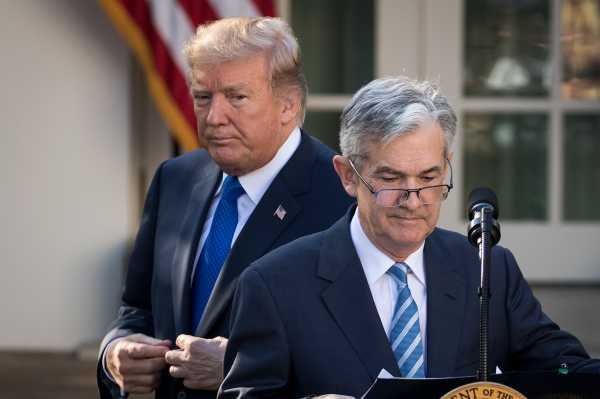
President Donald Trump is “not even a little bit happy” with the Federal Reserve and the man he tapped to lead it, Chair Jerome Powell. And he’s got no problem saying it.
Trump has been complaining about the Fed for a while now, putting on the pressure in interviews and on Twitter for the central bank to bend to his will when it comes to interest rates. In a sit-down with the Washington Post this week, he continued his Fed offensive, calling it a “much bigger problem than China” when it comes to the economy and expressing his anger with Powell, whom he chose as chair of the Fed in 2017 over then-Chair Janet Yellen, whose term expired in February.
“I’m doing deals, and I’m not being accommodated by the Fed,” Trump said. “I’m not happy with the Fed. They’re making a mistake because I have a gut, and my gut tells me more sometimes than anybody’s brain can ever tell me.”
The “mistake” he’s referring to is changing interest rates, one of the Federal Reserve’s main jobs. The Fed is responsible for influencing the availability and cost of credit in the American economy, and it does so by setting the “federal funds rate” — the interest rate banks charge each other for overnight loans. Banks, in turn, raise the interest rates they charge customers.
So why does Trump care about what the Fed is doing with interest rates? In a nutshell, he’s worried that when it increases rates, that will dampen the stock market he’s taken credit for and pump the brakes on the economic growth he’s promised.
William McChesney Martin, who led the Federal Reserve for nearly two decades, famously joked that the Fed’s job is to “take away the punch bowl just as the party gets going.” To continue the metaphor, like how some bars set the clock a bit fast to get everyone out the door before closing time, the Fed’s job is to cool down the economy just as things start getting fun.
Trump wants his party to keep going.
“This is really about his expectations of what a Fed chair looks like and what policy he thinks, in the short term, is most beneficial to him,” Sarah Binder, a political science professor at George Washington University, told me.
The Fed uses interest rates to influence the economy
When the Fed fears the economy might be overheating or sees inflation on the rise, it can hike interest rates to slow the whole thing down. That raises the cost of borrowing for banks and, in turn, for consumers, which eventually affects spending across the economy.
The bank has a “dual mandate,” a set of goals it is supposed to achieve: maximizing employment and stabilizing prices for goods and services. In practice, that means the Fed needs to try to keep the unemployment rate low — the idea being that if borrowing costs are low, businesses will have more money to invest and expand and ultimately hire more workers — and target an inflation rate of 2 percent, because a higher inflation rate is costlier than a lower one.
During the Great Recession, the Fed slashed interest rates to zero and kept them there for years in an effort to help the United States economy recover. The theory is that low interest rates boost both investment and consumption because it’s cheaper to borrow, and therefore, there’s less incentive to save.
In December 2015, the Fed raised rates for the first time since 2006, by 0.25 percentage points, and has been slowly raising them ever since, by a quarter of a percentage point each time, under both Yellen and Powell. Currently, the federal funds rate is 2 to 2.25 percent. The Fed is expected to hike rates by another quarter of a point in December.
That’s still low — prior to the financial crisis in 2006, they were at more than 5 percent. In the early 1980s, the Fed hiked rates to as much as 20 percent to fight inflation.
In a speech at the Economic Club of New York on Wednesday, Powell said that rates are “still low by historical standards” but are “just below the broad range of estimates of the level that would be neutral for the economy.” Stocks jumped in reaction.
Why Trump wants Powell to keep rates low
Trump has spent much of his presidency bragging about the stock market rally (which has recently waned) and promising a big boost in economic growth. Rising interest rates are a threat to that.
When interest rates rise, that can spook the stock market because it makes other classes of investments — such as bonds and CDs — more attractive. Zero and super-low interest rates in recent years have made stocks the only place for investors to make money, and the fear is that as the Fed raises rates, investors will start to look elsewhere. Higher rates make borrowing more expensive and slow down credit flows to companies and individuals, which could be a drag on stocks.
Rate increases can also slow the growth of the economy by making credit more expensive. The economy depends on debt to finance all kinds of growth patterns, from consumer holiday shopping to mortgages, and the more expensive it is to get credit, the less spending.
During his presidential campaign, Trump often criticized the Fed, alleging it was keeping interest rates artificially low in an effort to prop up the Obama economy. He seems to have been, in a way, telegraphing what he expects Powell to do for him.
He’s also looking for someone to point the finger at when the stock market starts acting up or if economic growth slows.
“What we’re seeing here is that Trump needs something to say that when things are great, it’s Trump, and when they are not, it’s someone else,” said Peter Conti-Brown, an assistant professor and financial historian at the Wharton School at the University of Pennsylvania. “That someone else, in this case, would be Jerome Powell and the Federal Reserve.”
Trump might not be wrong to question what the Fed is doing. But the way he’s going about it is weird.
The Fed has a tough balance to strike — raise interest rates enough to keep the economy from overheating, but avoid overdoing it so as to surprise markets or cause a recession. Fed Vice Chair Richard Clarida said in a recent interview with CNBC that Powell had compared the Fed’s plotting to being in a dark room, “especially without your shoes on, you want to go slow so you don’t stub your toe.”
And there are plenty of people who think the Fed might be acting too aggressively right now.
“This is a live debate, and the Fed is not privy to some sort of Platonic ideal about what interest rates must be,” Conti-Brown told me. “They don’t have that information, they’re guessing at it, and they’ll be the first to admit it.”
But the Fed is, at least theoretically, supposed to be an independent body that sets monetary policy free from political influence. It’s not unheard of for presidents to try to sway it one way or the other — Lyndon Johnson and Henry Truman clashed with the central bank — but most of the cajoling has taken place behind closed doors, especially since Bill Clinton, Binder said.
“Most presidents only do that when the economy is in rough shape, when they want looser rates and the Fed sees the need to tighten rates,” she said. “Trump is complaining when the economy is, at least on the surface, doing quite well.”
If anything, in fact, Trump’s policies — namely, the $1.5 trillion tax cut and increase in deficit spending — might be pushing the Fed to act more aggressively. The tax cut and spending are meant to stimulate the economy and could thus influence the Fed’s decision to raise rates to slow things down.
“In some sense, the Fed is following Trump here,” Conti-Brown said.
Of course, Trump didn’t have to pick Powell.
He could have renominated Yellen, who was appointed by President Barack Obama in 2012, since it’s been a norm for presidents to renominate Fed chairs picked by their predecessors. Yellen proved to be a steady hand at the Fed, is more qualified than Powell, and was a key player in steering the US economy through recovery after the recession. But Trump didn’t want her. (The Washington Post reported that part of Trump’s issue with Yellen was that at 5-foot-3, she was too short.)
It’s not clear whether Powell’s actions are much different than Yellen’s would have been, as both are considered to be rather dovish — meaning they prefer looser policies, such as low interest rates. And the Fed’s been on the current rate increase path for a while.
“What the Fed is doing here is part of a longer trend that began in earnest in 2015 but also was telegraphed in decision-making as early as 2012,” Conti-Brown said.
But Trump wanted to put in his own guy, and apparently with that, he expected loyalty — the same way he did with former Attorney General Jeff Sessions and former FBI Director James Comey. Kevin Warsh, a former Fed governor who was one of the contenders against Powell to replace Yellen, said in an interview this year that the Fed’s independence was “probably not an obvious feature to the president.”
It’s not clear what Trump might have told Powell in terms of expectations before appointing him, but what is obvious is that the president is not pleased with how this has played out.
“He seems to have this notion that Powell wasn’t going to be raising rates, that he wasn’t going to be tightening up the cost of credit,” Binder said. “I don’t know where Trump exactly got that notion, or if that’s just part of his expectations of what it means to be a loyal appointee of President Trump.”
Sourse: vox.com





